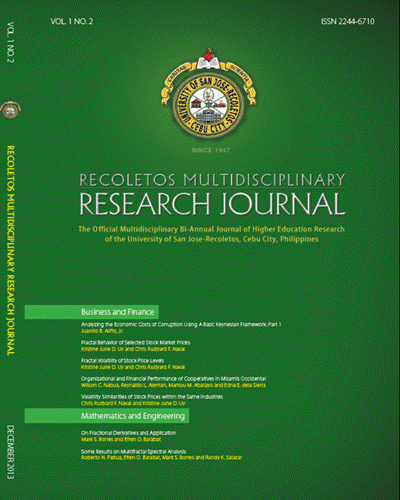Volatility Similarities of Stock Prices within the Same Industries
DOI:
https://doi.org/10.32871/rmrj1301.02.05Keywords:
fractals, fractals in finance, volatility similarities, same industries, stock price volatilityAbstract
It is prevalently known in finance, and even economics, that prices are the market players’ reflection of its collective reaction to the market. Market players’ perceptions on an industry may have direct effects on the volatility levels of its member stocks. Moreover, this theory may have certain effects on the fluctuation levels of stocks within the same industry, thereby; having
common intuitions on the industry brings similarities in volatility. Having this ideology, the researchers are fascinated in seeing fluctuation similarities, which may appear contrary to the notion that “there is uniqueness on each stock’s fluxesâ€. The study attempts to fill in the gap by studying volatility similarities of stocks with the same industry. Concentrating on volatility, the researchers utilized fractal statistics-- a newly developed science of fractals. The methodology enables users to analyze ruggedness of data in their unsmoothed state and create appropriate analysis. This study is also a test of fractal statistics as a risk measure that does not disregard the inherent ruggedness of the data set. The authors proposes, through fractal statistics, that the area of the data set’s ruggedness relates to the stock’s risk and compare it with other member stocks of the industry. Consequently, trends of stock’s fluctuations levels are compared with other industry-member stocks. It is identified that there are prominent similar trends within each chosen industries. It is found out that industry stocks’ fluctuation levels possess trend similarities and even posed same results with stocks in the same sector. Fractal statistics has been confirmed effective in exploring the phenomena on stock price volatility similarities.
References
Economics, Volume 9.
Gabriel, A. M., &Ugochukwu, W. M. (2012). Volatility estimation and stock price prediction in the nigerian stock market.International Journal of Financial Research, 3(1), 2. Retrieved from
http://search.proquest.com/docview/1030087889?accountid=33262
Kyröläinen, P. (2008). Day trading and stock price volatility. Journal of Economics and Finance, 32(1), 75-89. Retrieved from http://search.proquest.com/docview/215576863?accountid=33262
Padua, R. N. (2013, March). Data Roughness and Fractal Statistics. Cebu Normal University Journal of Higher Education. Cebu, Cebu, Philippines: Cebu Normal Press.
Platt, H., Platt, M., &Demirkan, S. (2011).Explaining stock price volatility with terminal value estimates. The Journal of Private Equity,
15(1), 16-25,4. Retrieved from http://search.
proquest.com/docview/912509754?accountid=33262
Ross, S. A. (1976). The arbitrage theory of capital asset pricing. Journal of Economic Theory, Voliume 13, Issue 3, 341–360.
Schwert, G. W. (1989a). Why Does Stock Market Volatility Change Over Time? Journal of Finance, 44(5), 1115-1153. http://dx.doi.
Org/10.llll/j.1540-6261.1989.tb02647.x
Schwert, G. W. (1989b). Business Cycles, Financial Crises, and Stock Volatility. Carnegie-Rochester Conference Series on Public Policy, Elsevier, 31(1), 83-125.
Downloads
Published
How to Cite
Issue
Section
License
Copyright of the Journal belongs to the University of San Jose-Recoletos


